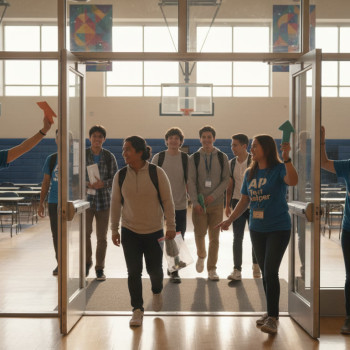Why test familiarity matters more than you think
If you picture the Digital SAT as a timed race, many students assume the solution is simply “try faster.” But speed on test day isn’t raw sprinting — it’s choreography, practiced footwork, and knowing the course so well that your feet move without thinking. Familiarity with the test transforms uncertainty into rhythm. The digital format’s adaptive design, new interface tools, and different pacing all reward students who have practiced not just the content, but the environment itself.
Speed is a byproduct of comfort
Think about the first time you cooked a complicated recipe versus the fifth time. The first run is slow, you misjudge heat and misplace tools. By the fifth run, your hands know where the knife is; you flow. The Digital SAT works the same way. Students who have only practiced problems on paper — or who only practice content without replicating test conditions — often lose valuable seconds on small but cumulative tasks: opening a passage, using on-screen tools, navigating between modules, or interpreting a new question type on the fly. Those seconds add up.
What makes the Digital SAT different — and where familiarity speeds you up
Two features of the Digital SAT are particularly important to understand:
- Multistage adaptive design: Each major section (Reading & Writing, Math) is split into two modules. Your performance in the first module determines the second. That means the experience can shift depending on how the first module goes, and having practiced multiple pathways reduces the shock of a change in difficulty.
- Digital interface and tools: The test runs in an app with specific navigation, a built-in calculator for math, annotation/highlight tools, and an on-screen timer. Speed comes from muscle memory with those tools.
Small comfort wins yield big time savings
When you’re familiar with the interface you stop losing time on tiny decisions. Consider these micro-delays students often experience:
- Hesitation while switching passages because the highlighting tool works slightly differently than in your browser.
- Scrolling too far and needing to scroll back for evidence in a passage.
- Unfamiliarity with the built-in calculator’s layout and available functions.
- Noticing adaptive behavior and panicking, which leads to rushed, careless mistakes.
Practice reduces all of these into sub-second motions, shaving minutes off your test time while improving accuracy.
Concrete structure and timing — learn it once, use it forever
Understanding exact section lengths and question counts removes guesswork and helps you plan pacing with purpose. When the structure is known and rehearsed, you allocate time intuitively, not anxiously.
| Component | Time Allotted | Number of Questions |
|---|---|---|
| Reading & Writing | 64 minutes (2 modules of 32 minutes) | 54 |
| Math | 70 minutes (2 modules of 35 minutes) | 44 |
| Total | 134 minutes (approximately 2 hours 14 minutes) | 98 |
Note: module lengths and question counts are predictable, which allows you to practice pacing down to the minute — and to rehearse how you’ll respond if a second module becomes harder or easier.
How familiarity with formats and tools translates to faster performance
1) Navigation fluency
When you’re practiced, you won’t waste time wondering whether to flag a question or move on. You’ll know how to mark a question, jump back to it, and track unanswered items quickly. Practice should include toggling between questions, using the review features, and simulating the limited breaks of test day so that your muscle memory handles navigation automatically.
2) Effective annotation and evidence retrieval
Digital highlighting and annotation let you mark evidence quickly — but only if you practice using them. Students who rehearse marking topic sentences, tagging evidence in passages, or tracking math problem information on the side of the screen do less re-reading and more answering.
3) Calculator confidence
The on-screen calculator can handle many tasks, but it’s laid out differently than the physical calculator some students prefer. Practicing math problems using the digital calculator eliminates fumbling and lets you focus on math strategy instead of button-hunting.
4) Adaptive thinking
Understanding that the test tailors difficulty stress-tests your mindset: a tougher second module doesn’t mean you’re failing; it means you performed well. Students who have practiced across multiple difficulty levels know how to adjust pacing and stay confident when questions get harder — a major psychological speed advantage.
Practice plans that build familiarity — not just content
To get faster, your practice has to include test-environment rehearsals and targeted drills. Here are several focused plans you can use depending on how much time you have.
Two-week sprint (for last-minute gains)
- Day 1: Take a timed full section (Reading & Writing) in the Bluebook or official digital practice environment. Focus on navigation and annotation tools, not score.
- Day 2: Review mistakes, but also note interface hesitations. Drill 20 reading questions focused on evidence retrieval.
- Day 3: Timed Math module practice using the on-screen calculator; practice three question types you struggle with.
- Days 4–10: Alternate full modules and targeted 30–45 minute drills, including one simulated full test in the app by day 10.
- Days 11–14: Light review, pacing checklists, and a final practice test 48–72 hours before test day. Practice login/setup process to avoid tech surprises.
Six-week program (balanced skill + familiarity)
- Week 1: Baseline full digital practice test. Note pacing and interface issues.
- Week 2: Skill focus (two days reading, two days writing, two days math), plus one practice module to rehearse tools each week.
- Week 3: Timed mixed modules with emphasis on adaptive module responses; practice both easier and harder second-module scenarios.
- Week 4: Targeted drills for weakest question types; include daily 15-minute interface practice (e.g., marking, calculator use).
- Week 5: Two full-length practice tests in the official app, mimicking test-day timing and breaks.
- Week 6: Review, error-log consolidation, and light practice with focus on speed and confidence-building.
Three-month plan (deep mastery)
Build skill foundations early, then layer familiarity once content mastery is reliable. This plan alternates content weeks with full-environment rehearsal weeks. Regularly simulate both easy and challenging second-module outcomes so you learn to pace regardless of difficulty.
Example drills that directly increase speed
Timed evidence skims (Reading)
Set a 3–4 minute timer per passage. Skim for main idea and annotate a two-line summary in the margin; answer the main 3–4 questions about that passage without re-reading more than once. This trains the brain to extract evidence fast and reinforces annotation habits on the digital interface.
Calculator fluency set (Math)
Choose 10 calculation-based problems and solve them all using the on-screen calculator only. Time yourself and reduce total time each repetition while keeping accuracy above 85%. This creates fluidity with the layout and keystrokes.
Adaptive mindset exercise
Take a module and grade it. Then intentionally take a harder module and practice the exact pacing you’d use if you encountered harder questions on test day: slow down, allocate more time per problem, and use process-of-elimination more deliberately. Doing both trains you to view difficulty as data, not danger.
How to measure improvement — metrics that matter
Speed without accuracy is a false victory. Track these metrics weekly and watch trends rather than day-to-day noise:
- Average time per question by section (Reading, Writing, Math).
- Percentage of questions answered with high confidence on first pass.
- Number of flagged questions completed before the end of a module.
- Error types (careless, misread, content gap) so you know whether speed or comprehension is the problem.
| Metric | Baseline | Target (6 weeks) |
|---|---|---|
| Avg. time/question (Reading) | ~70–80 seconds | ~55–65 seconds |
| Avg. time/question (Math) | ~90–110 seconds | ~65–80 seconds |
| Accuracy on first pass | ~70–80% | ~80–90% |
Adjust targets to your initial baseline. The important part is seeing consistent downward movement in time-per-question while maintaining or increasing accuracy.
Mindset and test-day rituals that preserve speed
Familiarity reduces surprises, which lowers anxiety and protects speed. Here are rituals that reinforce that familiarity:
- Replicate test-day setup at least once: log into the Bluebook app, complete check-in steps, and run through a practice module with the same allotted time and break schedule.
- Have a clear warm-up: 10 minutes of light reading and math drills the morning of the test to prime your brain for the types of thinking the SAT requires.
- Use a standardized toolbox: one method for marking, one way to structure math scratch work, and one consistent approach to reading passages. These small routines speed decision-making.
How a personalized approach accelerates familiarity — the role of guided practice
Independent practice is invaluable, but guided practice is catalytic. A tutor or coach identifies where interface or pacing hang-ups live and builds drills to resolve them. That’s why some students see big leaps by combining self-study with periodic 1-on-1 guidance: targeted feedback shortens the trial-and-error loop.
For example, Sparkl’s personalized tutoring pairs expert tutors with tailored study plans and AI-driven insights to pinpoint whether your slowdowns stem from navigation issues, conceptual gaps, or timing strategy. Sparkl can design drills that mimic the exact situations that trip you up and help you practice in the official digital environment so that by test day your reactions are automatic.
What targeted tutoring can do for your familiarity
- Quickly diagnose whether slow answers are due to misunderstanding question types or fumbling with tools.
- Create customized drills (e.g., 15-minute evidence sprints or calculator-only sets) and track progress across repeated sessions.
- Model test-day procedures and walk through mock setups so the real process is familiar and calm.
Real-world example: two students, two outcomes
Imagine Maya and Jamal, both aiming to improve their SAT scores by 60 points in two months.
- Maya focuses solely on content and completes practice questions from a workbook. She improves conceptually but hasn’t practiced the digital tools or the adaptive experience. On test day she spends extra time learning the markup tools and hesitates when a harder second module appears, losing time and composure.
- Jamal mixes content practice with weekly full-module practice in the official app, rehearses the calculator, and times evidence sprints. He also works with a tutor for three sessions to refine navigation strategies and error patterns. On test day he moves through questions fluidly, flags and returns efficiently, and uses the built-in tools without thinking. He hits his score goal with a calmer, faster test.
Both students learned the same math and reading skills — but Jamal translated those skills into faster, more accurate performance because his practice included the environment itself.
Common pitfalls when pursuing speed (and how to avoid them)
- Rushing at the expense of comprehension: Speed without comprehension creates careless mistakes. Use timed drills but always review errors to separate speed errors from knowledge gaps.
- Neglecting setup practice: Not practicing logging into Bluebook or using accommodation settings can cause panic. Do a full-tech rehearsal.
- Only practicing easy modules: If you avoid harder practice modules, you’ll be unprepared when the adaptive test makes things harder. Schedule practice on both difficulty levels.
Checklist for building familiarity week by week
Use this checklist to ensure your preparation includes environment-specific practice:
- Have you taken a full, timed practice test in the official app? (Yes / No)
- Do you practice the on-screen calculator for at least 30 minutes each week? (Yes / No)
- Do you use digital annotation and highlighting in every reading practice? (Yes / No)
- Do you practice both easier and harder second-module scenarios? (Yes / No)
- Have you run a full tech-check and test-day simulation? (Yes / No)
- Do you review and categorize errors after every practice module? (Yes / No)
Final thoughts — speed that feels like calm
Speed on the Digital SAT doesn’t come from frantic rushing. It comes from rehearsed calm: from practicing not only what questions ask, but how the test asks them. When the environment becomes familiar, your brain conserves energy for the real task — solving problems and interpreting evidence — and that energy is the engine behind faster, more accurate performance.
If you’re building a study plan, make sure you include repeated full-digital practice, tool drills, and at least a few simulated adaptive scenarios. If you want to compress your learning curve, combining independent practice with personalized tutoring can be a game-changer. Tutors can accelerate familiarity by diagnosing the precise moments where time is lost and designing drills that make those moments automatic. Sparkl’s personalized tutoring — with tailored study plans, 1-on-1 guidance, expert tutors, and AI-driven insights — is one such option to help students make the jump from “knowing content” to “performing swiftly and confidently” on test day.
Next steps you can take right now
- Book a single timed module in the official practice app to benchmark your speed and interface comfort.
- Create a two-week sprint focusing equally on interface practice and content — run evidence sprints and calculator sets every other day.
- Record your metrics and watch for trends: time per question, accuracy on first pass, and number of flagged-but-unfinished items.
- If you feel stuck, consider a short set of tutoring sessions to accelerate your familiarity and fix the specific sticking points that slow you down.
With repetition in the right environment, test day will feel less like a trap and more like a familiar course you’ve already run a dozen times. Your speed will follow naturally — and you’ll leave the test knowing you performed at your best.
Go practice — not just harder, but smarter
In the final week before your test, prioritize one last full-digital rehearsal, a calm sleep schedule, and simple morning routines that put your brain in the right rhythm. Familiarity breeds speed. Start building that familiarity today, and watch how quickly quiet confidence transforms into better pacing, fewer mistakes, and improved scores.














No Comments
Leave a comment Cancel